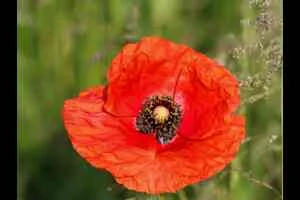Poppy refers to a group of flowering plants belonging to the Papaveraceae family. Poppies are known for their showy and colorful flowers, often featuring delicate petals and a distinctive seed pod. Here are some key facts about poppies:
1. Appearance: Poppies have distinct flowers with usually four to six petals, often in shades of red, orange, pink, purple, white, or a combination of these colors. The flowers can be single or double, and some varieties have a dark center known as a "black eye." Poppies have soft, delicate foliage and a seed pod called a capsule.
2. Types of Poppies: There are many species of poppies, but some commonly known ones include the Oriental poppy (Papaver orientale), California poppy (Eschscholzia californica), Iceland poppy (Papaver nudicaule), and opium poppy (Papaver somniferum). Each species has its own growth habits, flower forms, and preferred growing conditions.
3. Cultivation: Poppies are relatively easy to grow, and many species are suitable for both garden beds and containers. They typically prefer full sun and well-drained soil. Poppies can be grown from seeds, which are often sown directly in the garden in the spring or fall. Some species are annuals, while others are perennial or biennial.
4. Symbolism: Poppies carry different symbolic meanings in various cultures and contexts. They can symbolize remembrance, especially in relation to fallen soldiers, as seen with the red poppies associated with Armistice Day or Remembrance Day. Poppies can also symbolize beauty, resurrection, and consolation.
5. Medicinal and Culinary Uses: Some poppy species, particularly the opium poppy, have been used for their medicinal properties. The seeds of certain poppy varieties are used in cooking and baking, often as a topping for bread or pastries. Poppy seeds are known for their nutty flavor and are also used in making oils and condiments.
6. Opium Production: The opium poppy (Papaver somniferum) is well-known for its latex, which contains alkaloids used to produce opium, morphine, and other pharmaceutical drugs. It is important to note that the cultivation, production, and use of opium poppies and their derivatives are strictly regulated due to their potential for abuse and legal restrictions in many countries.
Poppies are cherished for their vibrant colors, delicate beauty, and cultural significance. Whether enjoyed in gardens, used symbolically, or appreciated for their culinary uses, poppies add a touch of charm and diversity to the natural world.




Why is the Opium Bird Mystery Captivating Millions? revolves around a peculiar and elusive artifact—an ancient statuette depicting a bird, believed to be associated with the opium trade. The origins of this artifact remain shrouded in mystery, with no clear historical record or definitive explanation of its purpose.
ReplyDelete